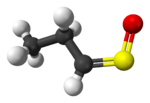- This page was last modified on 17 October 2025, at 10:18. Suggest an edit.
syn-Propanethial-S-oxide facts for kids
| syn-Propanethial S-oxide | |
|---|---|
 |
|
 |
|
| IUPAC name | (Z)-propylidene-λ4-sulfanone |
| Other names | Thiopropanal S-oxide 1-Sulfinylpropane |
| Identifiers | |
| CAS number | |
| PubChem | |
| SMILES | O=S=C/CC |
|
InChI
InChI=1/C3H6OS/c1-2-3-5-4/h3H,2H2,1H3
|
|
| Properties | |
| Molecular formula | |
| Molar mass | 0 g mol-1 |
| Except where noted otherwise, data are given for materials in their standard state (at 25 °C, 100 kPa) | |
syn-Propanethial S-oxide is a special chemical. It is the main reason why your eyes sting and water when you cut onions. This chemical is a type of liquid that easily turns into a gas. When this gas touches your eyes, it makes them tear up.
Contents
Why Onions Make You Cry
When you slice an onion, you break open its cells. Inside these cells are different chemicals and special helpers called enzymes.
How the Chemical is Made
When onion cells break, they release enzymes called alliinases. These enzymes start a chain reaction. They break down other chemicals in the onion. This creates something called 1-propenesulfenic acid.
But the story doesn't end there! A second enzyme, called lachrymatory factor synthase (or LFS), quickly changes this acid. It turns it into syn-propanethial S-oxide.
What Happens Next
The syn-propanethial S-oxide quickly turns into a gas. This gas floats up into the air. When it reaches your eyes, it touches the tiny nerves there. These nerves send a signal to your brain. Your brain then tells your tear glands to make tears.
The tears are your body's way of washing away the irritating gas. They help to dilute it and flush it out of your eyes.
Other Plants with Similar Chemicals
Did you know that other plants can also make chemicals that cause tears? For example, a plant called Allium siculum has a similar chemical. It is called syn-butanethial S-oxide. This shows that the Allium family of plants, which includes onions, has some interesting chemical tricks!
See also
 In Spanish: Sulfóxido de tiopropanal para niños
In Spanish: Sulfóxido de tiopropanal para niños
